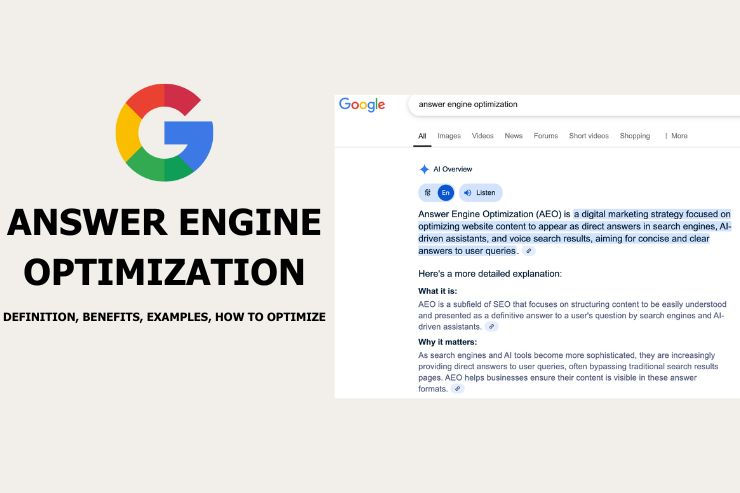Answer Engine Optimization (AEO) - Definition, Examples, How to Do & Where to Learn
- Pradhumnya khanayat
- Mar 26
- 3 min read
Updated: May 6

What is Answer Engine Optimization (AEO)?
Answer Engine Optimization (AEO) is the practice of optimizing digital content to rank in answer engines like Google’s Featured Snippets, ChatGPT, Perplexity AI, and other AI-driven search tools. Unlike traditional SEO, which focuses on improving website rankings in search engine results pages (SERPs), AEO aims to ensure content is structured and formatted to provide direct, concise, and authoritative answers.
How Answer Engines (LLM) Work?
Answer engines function by analyzing vast amounts of content to provide precise responses to user queries. Instead of displaying a list of web pages like traditional search engines, answer engines extract the most relevant information and present it directly. AI-driven models, natural language processing (NLP), and structured data play a crucial role in determining which content is selected.
AEO vs. SEO: How AEO Differs from SEO
While SEO focuses on optimizing content for search engines using keywords, backlinks, and technical SEO, AEO prioritizes delivering clear and authoritative answers. Key differences include:
Content Focus: AEO targets answer boxes, snippets, and AI-generated responses, while SEO optimizes for SERPs.
Query Intent: AEO is designed to address direct queries in an informative manner, while SEO may also cater to general information, transactional searches, and navigational queries.
Data Structuring: AEO relies more on structured data, schema markup, and conversational optimization to enhance AI accessibility.
Types of Answer Engines
Search Engine-Based Answer Engines: Google’s Featured Snippets, People Also Ask (PAA), Bing’s Direct Answers.
AI-Powered Chatbots: ChatGPT, Perplexity AI, Bard.
Voice Assistants: Siri, Alexa, Google Assistant.
Enterprise-Specific Answer Engines: Internal company knowledge bases, automated customer support systems.
Benefits of Answer Engine Optimization
Increased Visibility: Appearing in featured answers boosts credibility and engagement since your website is available to users in the first fold of google search.
Higher Click-Through Rates (CTR): Users are more likely to visit authoritative sources from AI overview sections.
Better User Experience: Quick, precise answers improve customer satisfaction.
Competitive Edge: Early adoption of AEO helps brands stand out in an AI-driven search landscape.
Answer Engine Optimization Examples
Google Featured Snippet: A concise answer appearing at the top of search results.
People Also Ask (PAA): Expanding Q&A format providing additional related information.
Voice Search Optimization: Structuring content for voice assistants to generate spoken responses. For eg- Try searching for "What is SEO?" from voice search and look at the answer you get in response.
AI-Powered Chatbots: Optimized knowledge bases enabling automated support.
How to Do Answer Engine Optimization
1. Conduct Question-Based Keyword Research
Use tools like AnswerThePublic, AlsoAsked, and Google’s PAA to find frequently asked questions.
Identify long-tail keywords and conversational queries that align with user intent.
2. Create Structured, Concise, and Authoritative Content
Write in a question-answer format.
Provide direct, factual, and well-cited responses.
Use bullet points and numbered lists for readability.
3. Implement FAQs, Lists & Schema Markup
Use FAQ schema and How-To schema to enhance search engine understanding.
Apply structured data to enable rich snippets.
4. Optimize for Voice Search
Use natural language and conversational tones.
Aim for short, clear responses (30-60 words per answer).
5. Leverage Internal Linking and Content Hierarchy
Create topic clusters with interlinked content.
Ensure logical navigation for user experience and search engines.
6. Monitor and Track Performance
Use Google Search Console and analytics tools to track snippet performance.
Adjust strategy based on user engagement, CTR, and ranking shifts.
How to Track Performance from AEO
Google Search Console: Monitor featured snippet rankings and keyword queries.
Google Analytics Tools: Measure user sessions, time spent, click-through rates and engagement levels.
Voice Search Reports: Identify how your content performs in voice-assisted queries.
Third-Party SEO Tools: Use SEMrush, Ahrefs, SimilarWeb, or Moz to track answer-based visibility.
Where to Learn Answer Engine Optimization
Online Courses
Google Digital Garage: Covers structured data and AI-driven search.
Coursera & Udemy: Offer specialized AEO and voice search optimization courses.
SEO-focused platforms like SEMrush Academy and Moz Academy.
Blogs & Industry Websites
Search Engine Journal
Search Engine Land
Google’s Search Central Blog
Hands-on Experience
Optimize existing content with AEO techniques.
Experiment with structured data and featured snippet optimizations.
What is GEO vs SEO?
GEO is Generative Engine Optimization, whereas SEO is Search Engine Optimization. Both techniques aim to improve online visibility with SEO focusing on traditional ranking methods to rank on Google, while GEO targets AI-driven search on major search engine platforms or LLMs that generate responses, not just results.
Conclusion
Answer Engine Optimization is the future of digital search, ensuring content is optimized for direct answers in AI-driven platforms. By leveraging structured data, question-based content, and authoritative sources, businesses can enhance their visibility and user engagement. Implementing AEO alongside SEO will be key to maintaining a strong digital presence in an evolving search landscape.

Comments